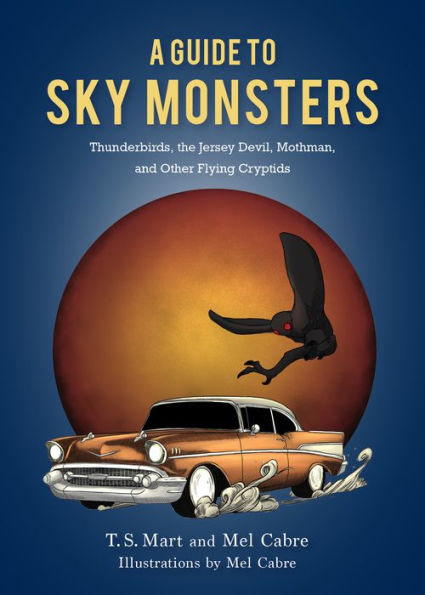A Guide to Sky Monsters: Thunderbirds, the Jersey Devil, Mothman, and Other Flying Cryptids
When a dark shadow passes overhead, do you stop? Or do you run? Infamous sky monsters have haunted our imaginations for centuries. The Thunderbird, steeped in Native American folklore, supposedly controls evil by throwing lightning. The Jersey Devil is said to roam the Pine Barrens of South Jersey, terrorizing anyone who crosses its path. And the cryptic warnings of Mothman have worried residents of Point Pleasant, West Virginia, since the 1960s. In A Guide to Sky Monsters: Thunderbirds, the Jersey Devil, Mothman, and Other Flying Cryptids, authors T. S. Mart and Mel Cabre introduce 20 flying cryptids with legends that span the United States. With 70 hand-drawn illustrations, A Guide to Sky Monsters details our fascination with these creatures and describes both historical evidence found in the fossil record and the specifics of modern-day sightings. By studying the fact, fiction, and pop culture surrounding these notorious beasts, Mart and Cabre help us lean into the question, "What if?"A Guide to Sky Monsters, perfect for the believer and skeptic alike, addresses the wider truths about flying cryptids and leaves us all to wonder whether that breeze was the wind or a wing.
1137483242
A Guide to Sky Monsters: Thunderbirds, the Jersey Devil, Mothman, and Other Flying Cryptids
When a dark shadow passes overhead, do you stop? Or do you run? Infamous sky monsters have haunted our imaginations for centuries. The Thunderbird, steeped in Native American folklore, supposedly controls evil by throwing lightning. The Jersey Devil is said to roam the Pine Barrens of South Jersey, terrorizing anyone who crosses its path. And the cryptic warnings of Mothman have worried residents of Point Pleasant, West Virginia, since the 1960s. In A Guide to Sky Monsters: Thunderbirds, the Jersey Devil, Mothman, and Other Flying Cryptids, authors T. S. Mart and Mel Cabre introduce 20 flying cryptids with legends that span the United States. With 70 hand-drawn illustrations, A Guide to Sky Monsters details our fascination with these creatures and describes both historical evidence found in the fossil record and the specifics of modern-day sightings. By studying the fact, fiction, and pop culture surrounding these notorious beasts, Mart and Cabre help us lean into the question, "What if?"A Guide to Sky Monsters, perfect for the believer and skeptic alike, addresses the wider truths about flying cryptids and leaves us all to wonder whether that breeze was the wind or a wing.
27.0
In Stock
5
1

A Guide to Sky Monsters: Thunderbirds, the Jersey Devil, Mothman, and Other Flying Cryptids
214
A Guide to Sky Monsters: Thunderbirds, the Jersey Devil, Mothman, and Other Flying Cryptids
214
27.0
In Stock

Product Details
| ISBN-13: | 9781684351244 |
|---|---|
| Publisher: | Red Lightning Books |
| Publication date: | 05/25/2021 |
| Pages: | 214 |
| Product dimensions: | 6.20(w) x 9.10(h) x 0.70(d) |
| Age Range: | 18 Years |
About the Author
What People are Saying About This
From the B&N Reads Blog
